The Influence of Injection Strategy on the Ignition Characteristics of Diesel/Ammonia Premixture
Abstract
:1. Introduction
2. Materials and Methods
2.1. Experimental Setup
2.2. Experimental and Calculation Conditions
2.3. Establishment and Calibration of the CFD Model
3. Results and Discussion
3.1. Effects of Injection Pressure of Pilot Diesel
3.2. Effects of Injection Timing of Pilot Diesel
3.3. Effects of Pre-Injection of Pilot Diesel
4. Conclusions
- (1)
- Appropriately increasing the injection pressure contributes to the atomization of the pilot diesel and improves the ignition conditions of the premixture, which shortens the ignition delay and makes the maximum projected flame area increase with the increase in injection pressure. At low equivalence ratios, the injection pressure has very little effect on the maximum combustion pressure, but it can increase the peak heat release rate and slightly advance its occurrence time. After increasing the equivalence ratio, although excessive injection pressure can increase the maximum combustion pressure, it reduces the peak heat release rate.
- (2)
- The closer the injection timing is to the TDC, the shorter the ignition delay is, the faster the flame’s early development is, and the larger the projected flame area is. The advancement of the injection timing makes the premixture more uniform. Although the ignition delay is prolonged, the projected flame area grows fast in the later stage, and the total projected flame area is larger. The advancement of the injection timing increases the maximum combustion pressure and the peak heat release rate.
- (3)
- The strategy of pre-injecting a portion of diesel can effectively shorten the ignition delay, resulting in increased cylinder pressure and heat release rate. Additionally, the heat release rate presents a double-peak feature under this strategy. It is speculated that the first peak is likely caused by the low-temperature reaction of pre-injected diesel and the second peak is caused by the heat release of the ammonia premixture.
Author Contributions
Funding
Data Availability Statement
Conflicts of Interest
References
- Al-Hamamre, Z.; Yamin, J. The Effect of Hydrogen Addition on Premixed Laminar Acetylene–Hydrogen–Air and Ethanol–Hydrogen—Air Flames. Int. J. Hydrog. Energy 2013, 38, 7499–7509. [Google Scholar] [CrossRef]
- Lv, X.; Yan, X.; Lei, M.; Hou, Y.; Chen, L.; Wang, Y.; Qi, C.; Yu, X.; Yu, J. Propagation of High-Speed Hydrogen-Air Combustion Waves through Inert Gases. Fuel 2023, 345, 128205. [Google Scholar] [CrossRef]
- Kurien, C.; Mittal, M. Review on the Production and Utilization of Green Ammonia as an Alternate Fuel in Dual-Fuel Compression Ignition Engines. Energy Convers. Manag. 2022, 251, 114990. [Google Scholar] [CrossRef]
- Shu, T.; Xue, Y.; Zhou, Z.; Ren, Z. An Experimental Study of Laminar Ammonia/Methane/Air Premixed Flames Using Expanding Spherical Flames. Fuel 2021, 290, 120003. [Google Scholar] [CrossRef]
- Dai, L.; Gersen, S.; Glarborg, P.; Mokhov, A.; Levinsky, H. Autoignition Studies of NH3/CH4 Mixtures at High Pressure. Combust. Flame 2020, 218, 19–26. [Google Scholar] [CrossRef]
- Gray, J.T., Jr.; Dimitroff, E.; Meckel, N.T.; Quillian, R.D., Jr. Ammonia Fuel-Engine Compatibility and Combustion. SAE Trans. 1966, 660156. [Google Scholar]
- Wen, M.; Liu, H.; Cui, Y.; Ming, Z.; Feng, L.; Wang, G.; Yao, M. Study on Combustion Stability and Flame Development of Ammonia/n-Heptane Dual Fuel Using Multiple Optical Diagnostics and Chemical Kinetic Analyses. J. Clean. Prod. 2023, 428, 139412. [Google Scholar] [CrossRef]
- Wu, B.; Zi, Z.; Jin, S.; Pei, Y.; Wang, D. Effect of Diesel Injection Strategy and Ammonia Energy Fraction on Ammonia-Diesel Premixed-Charge Compression Ignition Combustion and Emissions. Fuel 2024, 357, 129785. [Google Scholar] [CrossRef]
- Niki, Y.; Nitta, Y.; Sekiguchi, H.; Hirata, K. Diesel Fuel Multiple Injection Effects on Emission Characteristics of Diesel Engine Mixed Ammonia Gas into Intake Air. J. Eng. Gas Turbines Power 2019, 141, 061020. [Google Scholar] [CrossRef]
- Li, T.; Zhou, X.; Wang, N.; Wang, X.; Chen, R.; Li, S.; Yi, P. A Comparison between Low- and High-Pressure Injection Dual-Fuel Modes of Diesel-Pilot-Ignition Ammonia Combustion Engines. J. Energy Inst. 2022, 102, 362–373. [Google Scholar] [CrossRef]
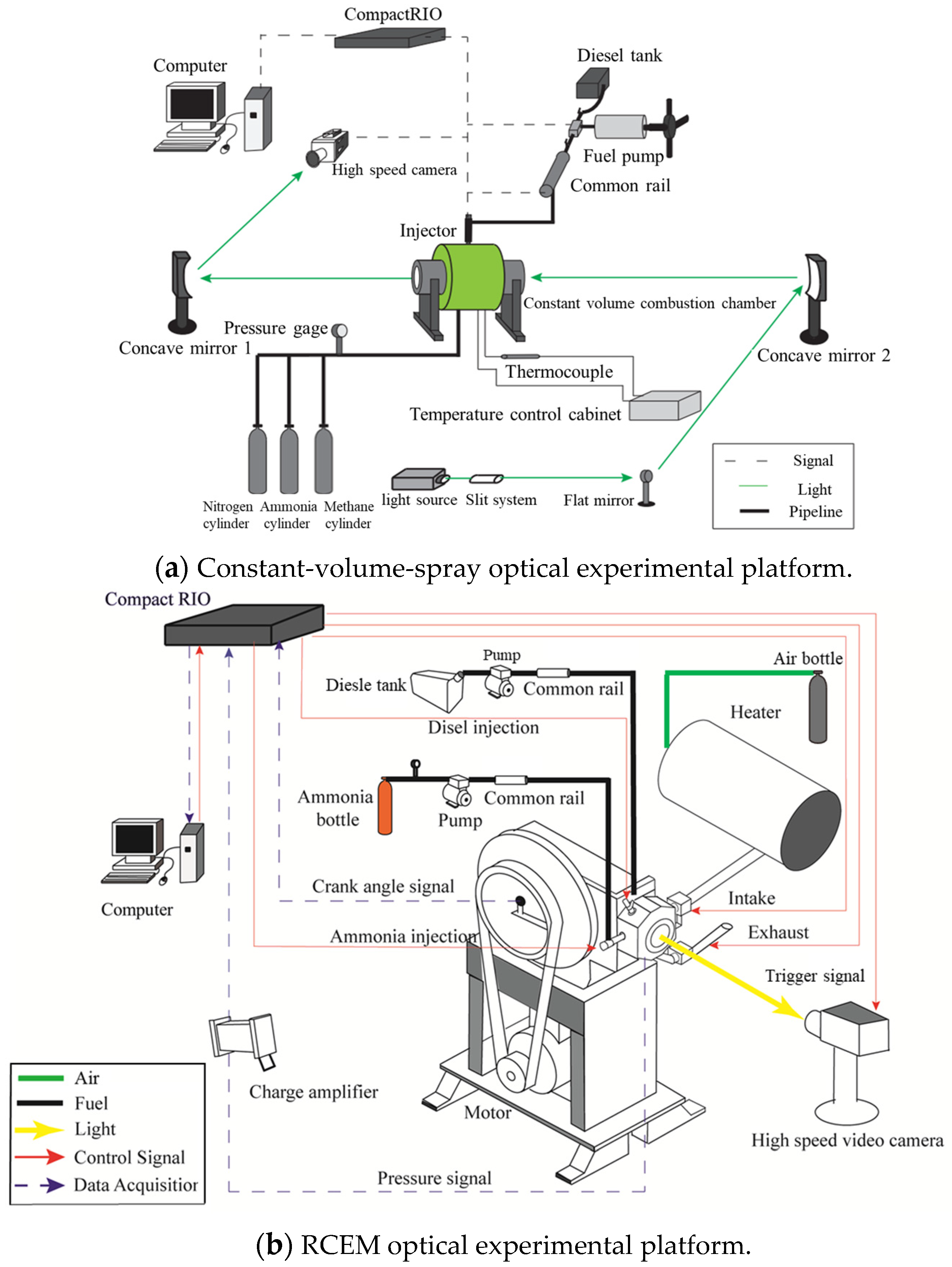

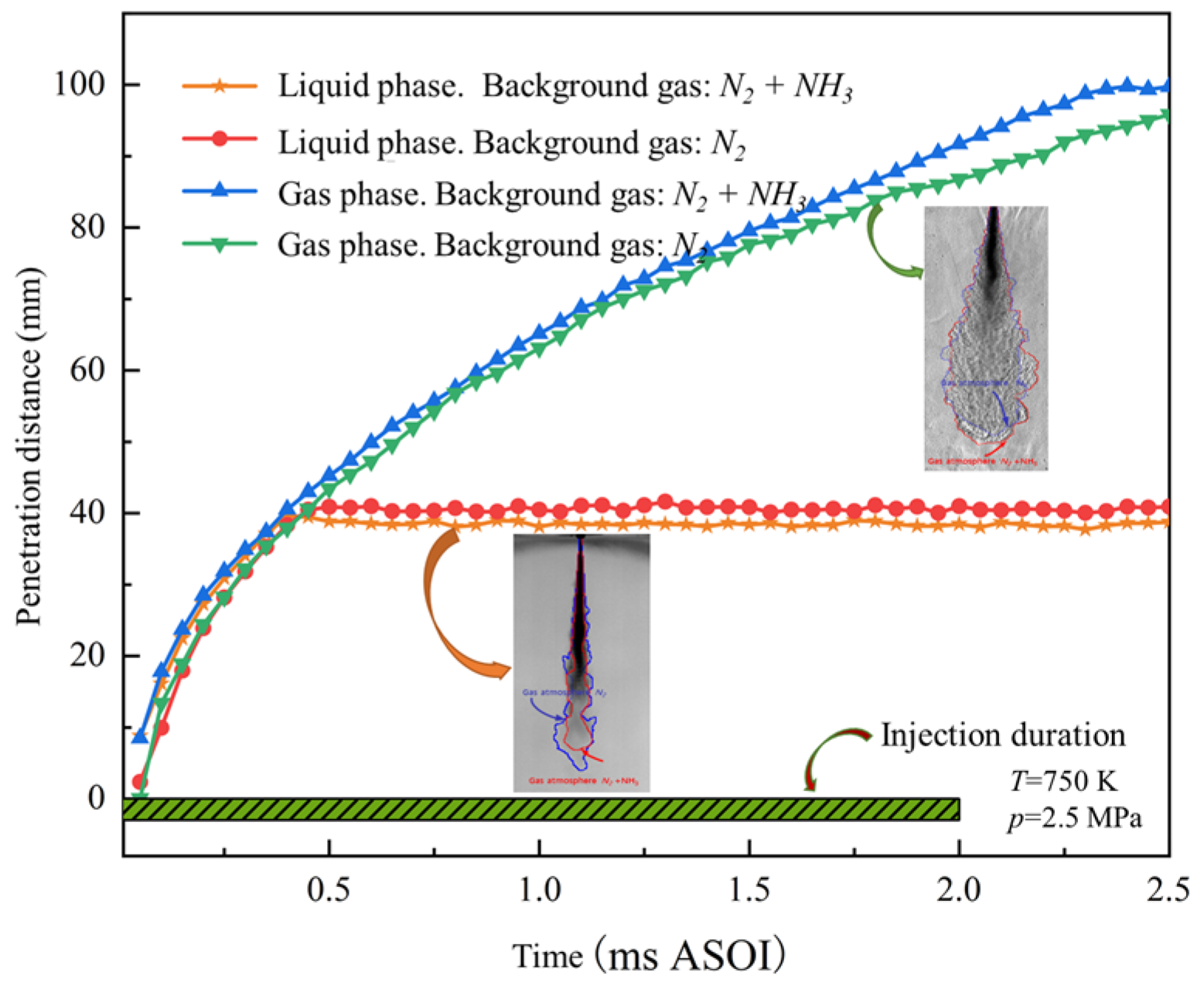
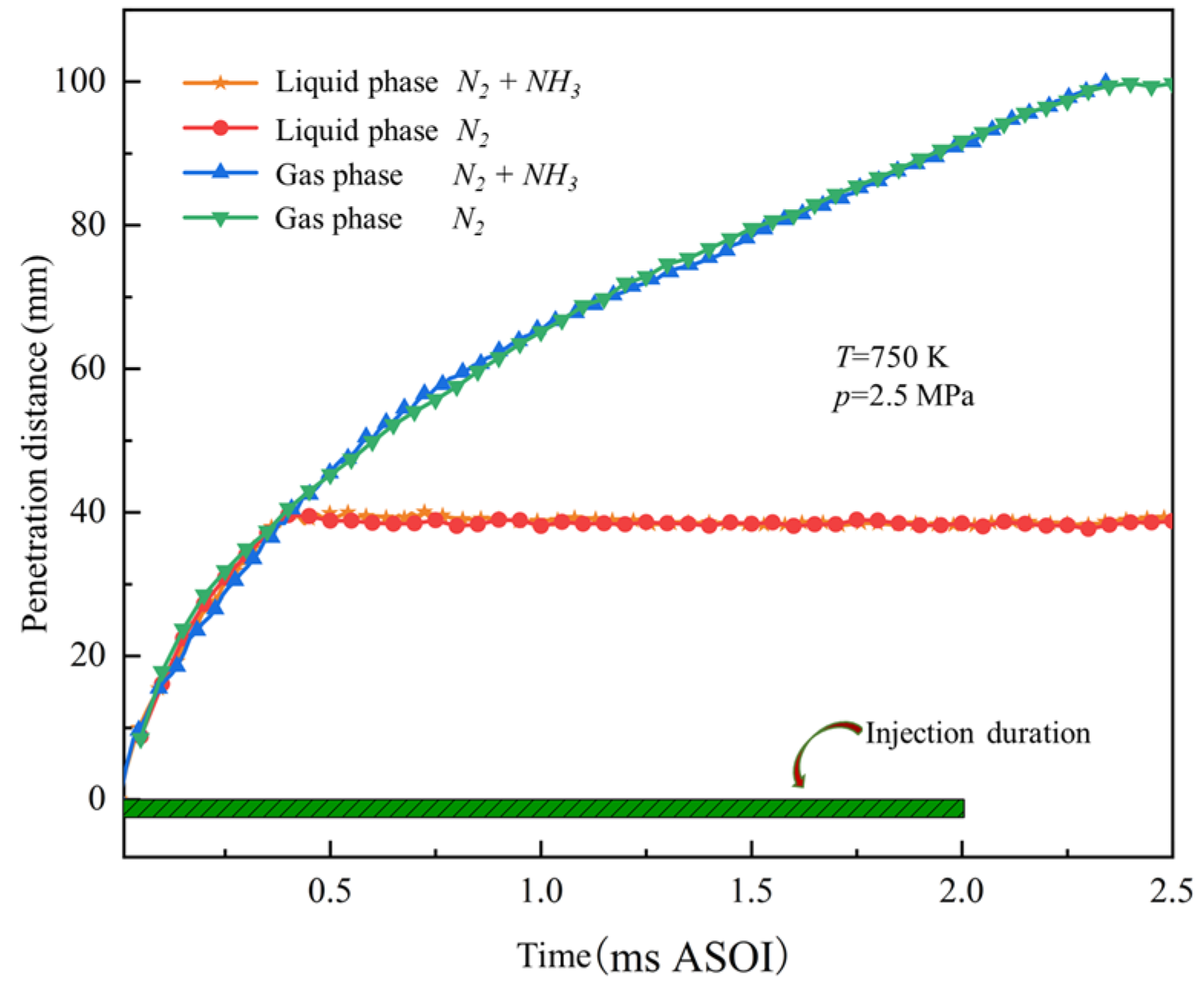



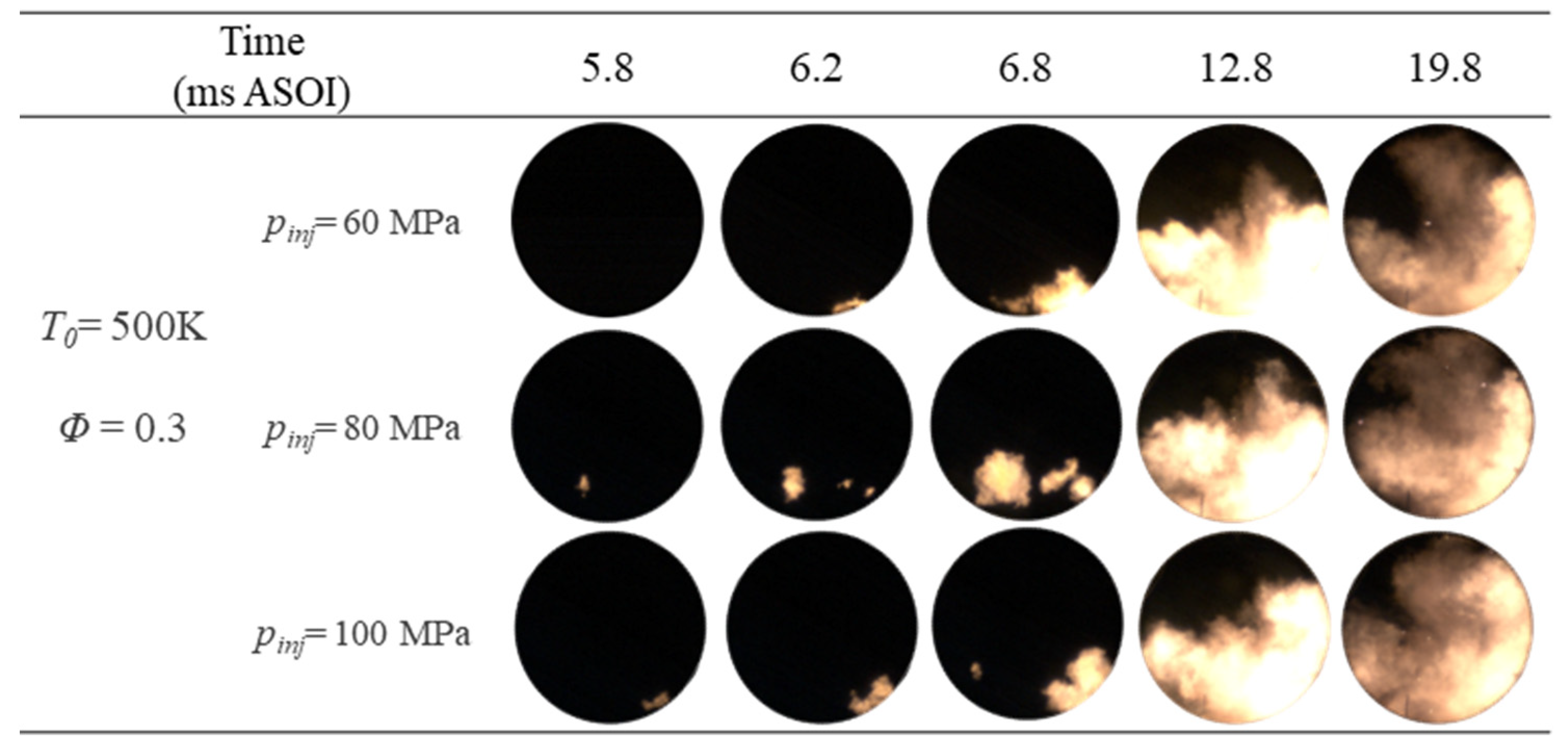
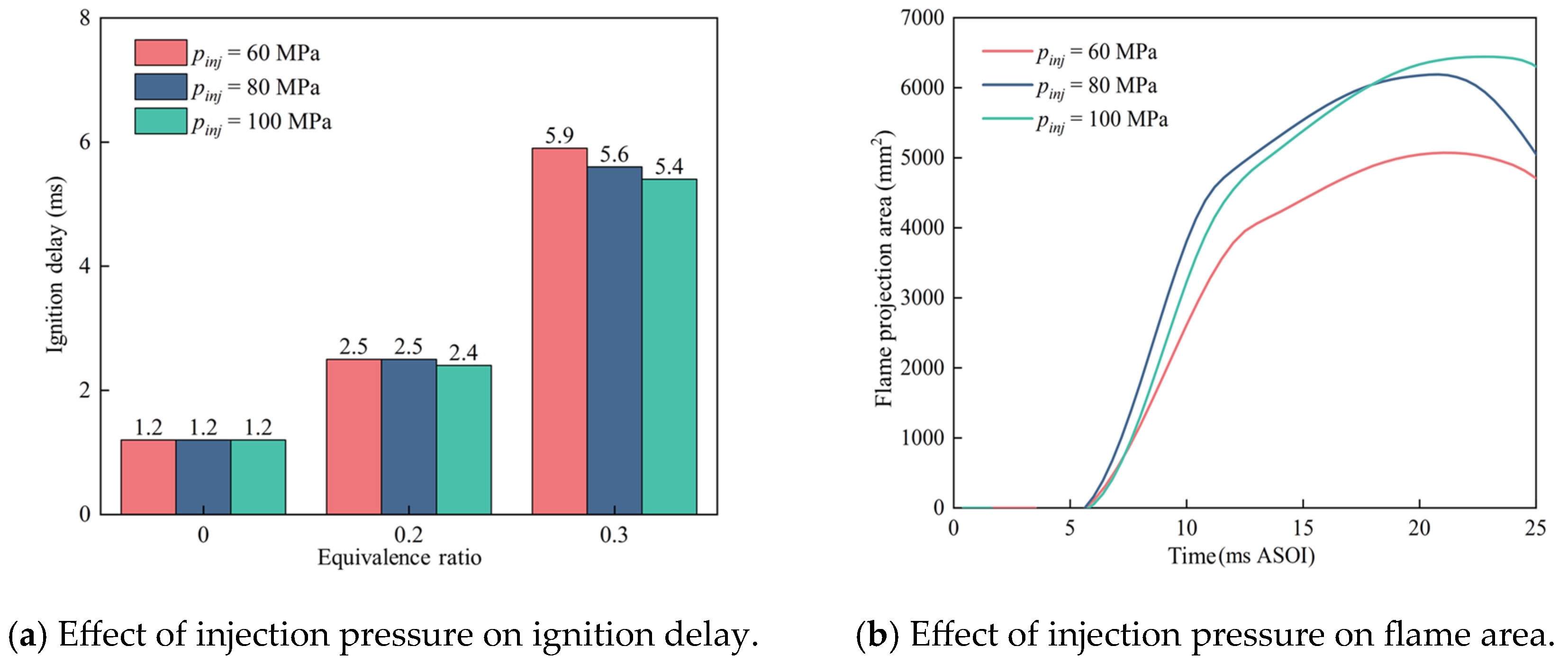

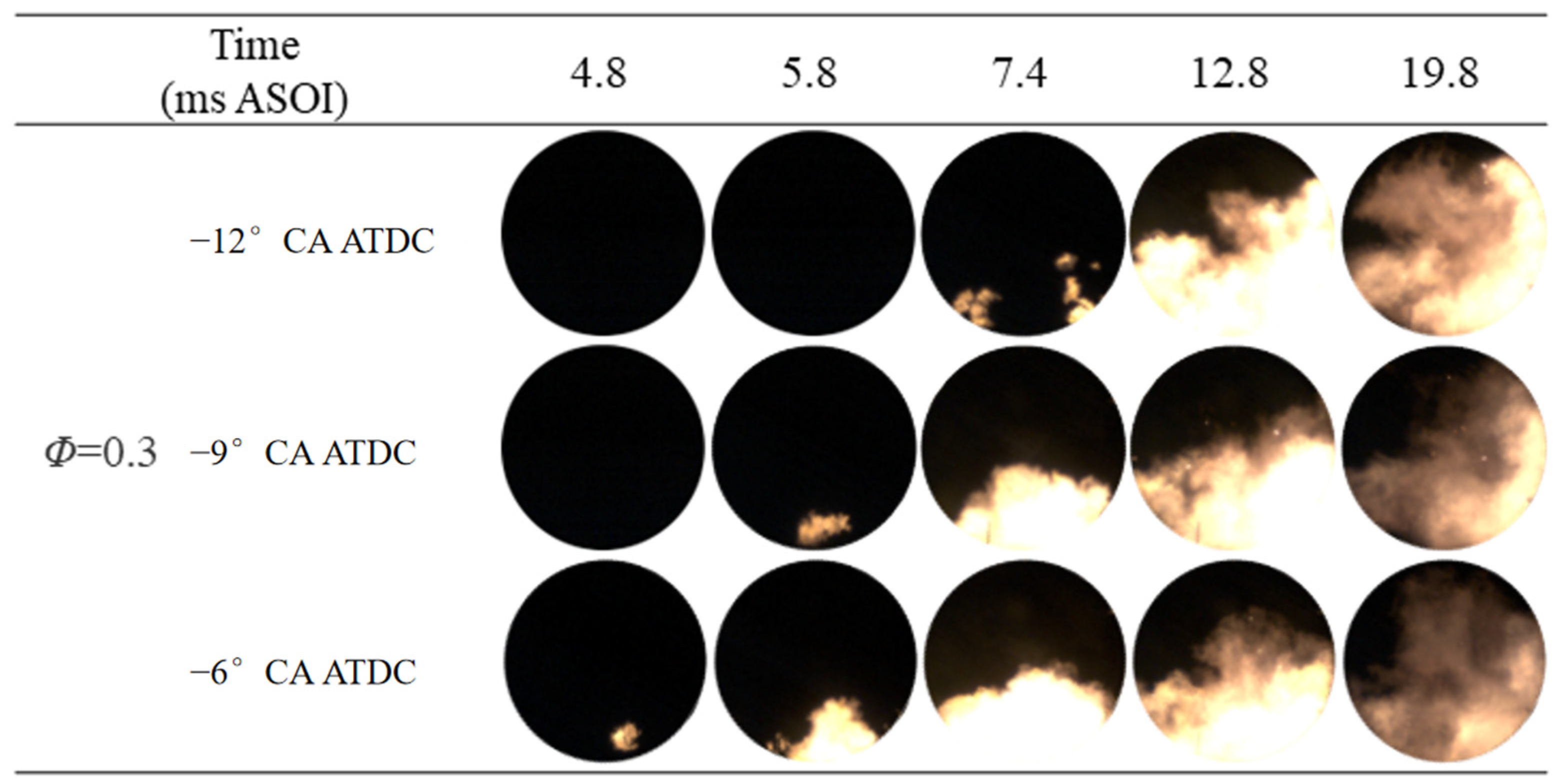
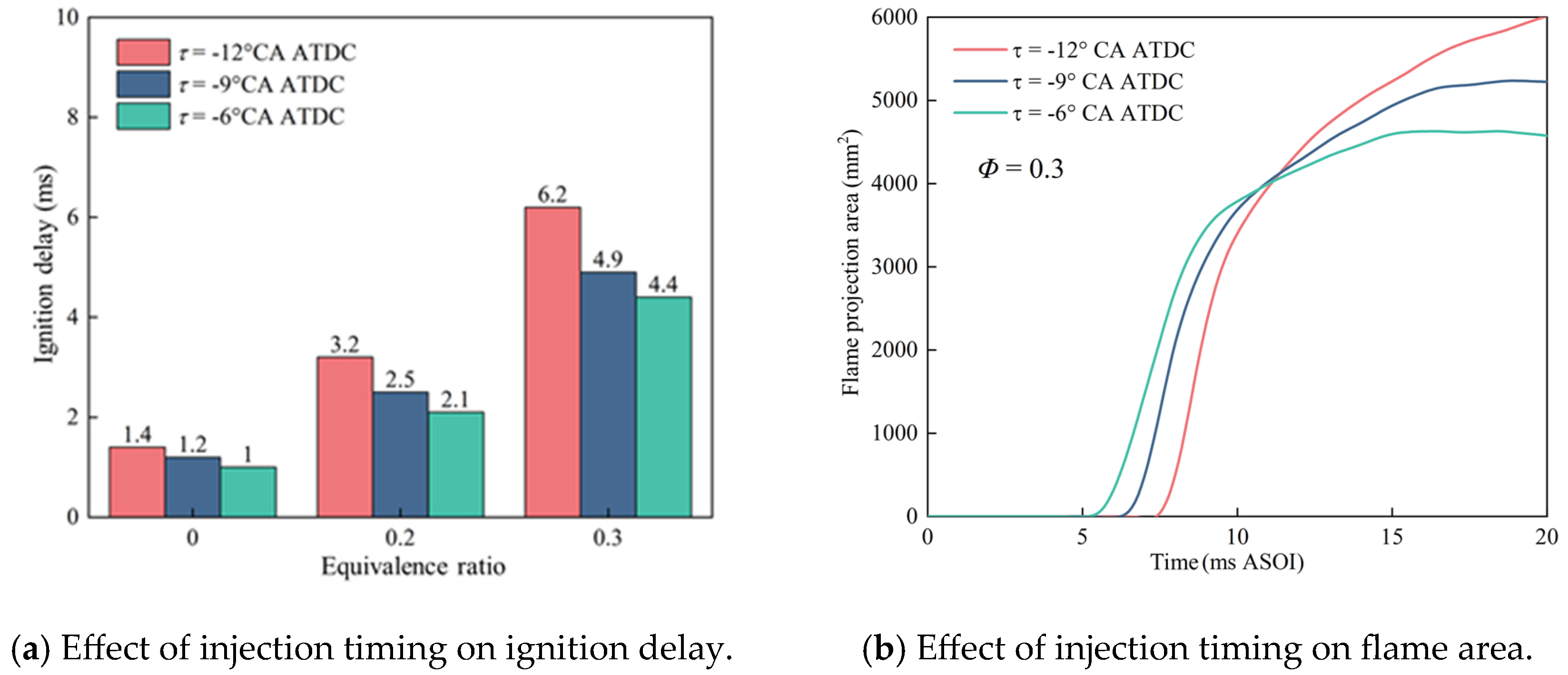
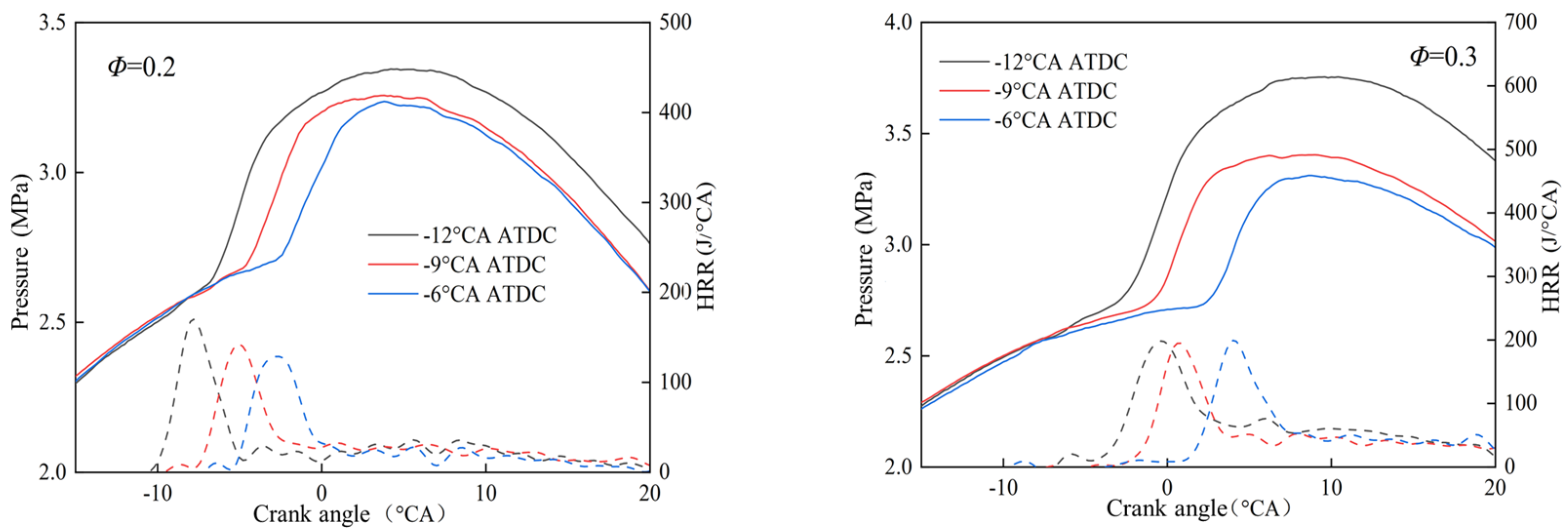
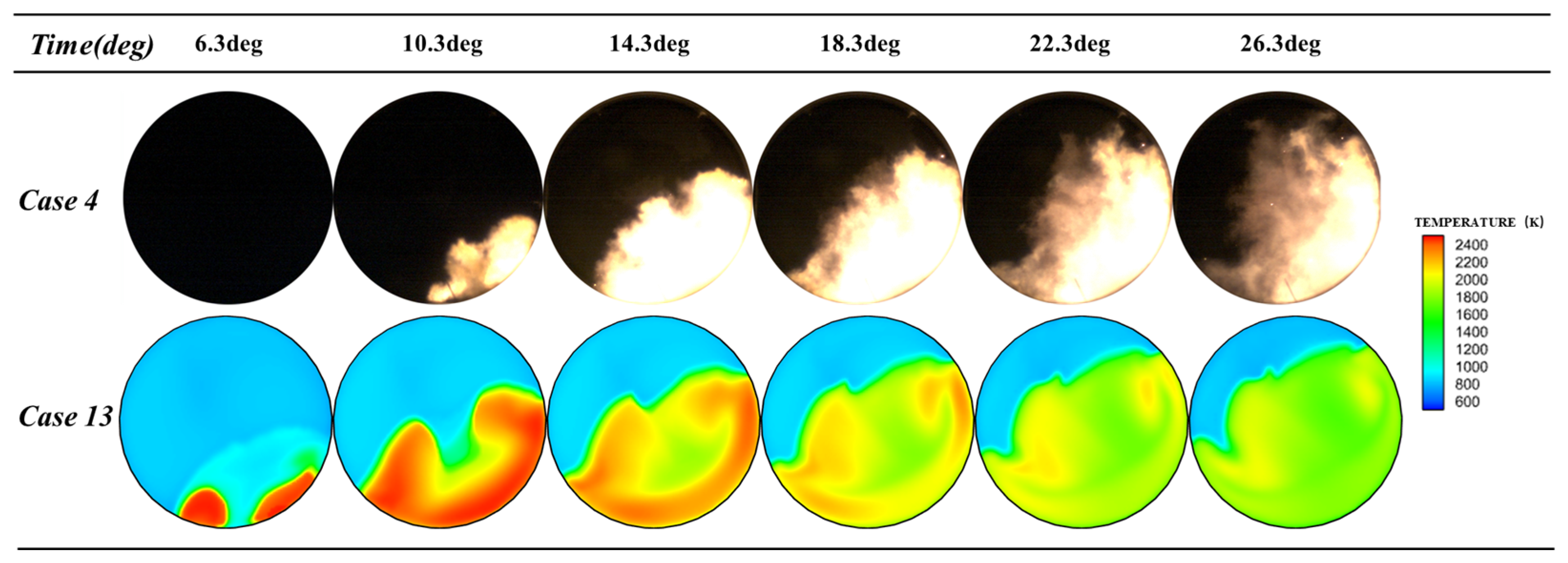
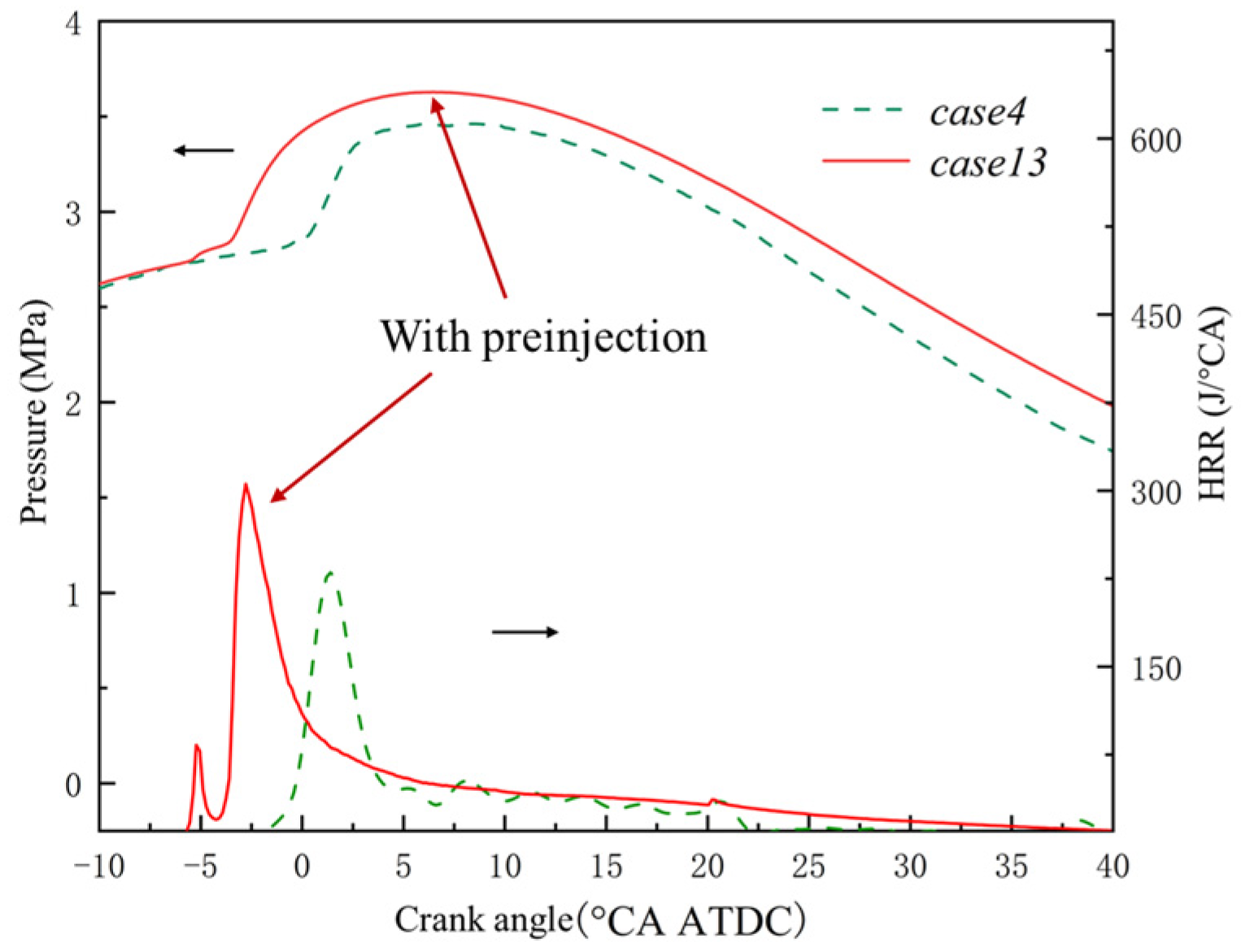
| Gasoline | Diesel | Methane | Hydrogen | Ammonia | |
|---|---|---|---|---|---|
| Low heating value (MJ/kg) | 44.5 | 43.4 | 38.1 | 120.1 | 18.8 |
| Flammability limit (Vol.%) | 1.4–7.6 | 0.6–5.5 | 5–15 | 4–75 | 16–25 |
| Laminar burning velocity at Φ = 1.0 (cm/s) | 58 | 86 | 38 | 351 | 7 |
| Autoignition temperature (°C) | 300 | 230 | 450 | 571 | 651 |
| Minimum ignition energy (MJ) | 0.14 | — | — | 0.018 | 8.0 |
| Octane rating | 90–98 | — | 107 | >130 | 111 |
| Latent heat of vaporization (KJ/kg) | 71.78 | 47.86 | 104.8 | — | 1369 |
| Temperature/K | Pressure/MPa | Equivalence Ratio | Injection Pulse Width/ms | Injection Pressure/MPa | |
|---|---|---|---|---|---|
| 1 | 750 | 2.5 | 0 | 2 | 80 |
| 2 | 750 | 2.5 | 0.5 | 2 | 80 |
| Equivalence Ratio | Nozzle Diameter/mm | Injection Pressure/MPa | Diesel Injection Timing/deg | Pre-Spray | Injection Pulse Width/ms | Research Approach | |
|---|---|---|---|---|---|---|---|
| 1 | 0.2 | 0.12 | 60 | −9 | No | 3.5 | Experiment |
| 2 | 0.2 | 0.12 | 80 | −9 | No | 2.8 | Experiment |
| 3 | 0.2 | 0.12 | 100 | −9 | No | 2.3 | Experiment |
| 4 | 0.3 | 0.12 | 60 | −9 | No | 3.5 | Experiment |
| 5 | 0.3 | 0.12 | 80 | −9 | No | 2.8 | Experiment |
| 6 | 0.3 | 0.12 | 100 | −9 | No | 2.3 | Experiment |
| 7 | 0.2 | 0.12 | 60 | −6 | No | 3.5 | Experiment |
| 8 | 0.2 | 0.12 | 60 | −12 | No | 3.5 | Experiment |
| 9 | 0.3 | 0.12 | 60 | −6 | No | 3.5 | Experiment |
| 10 | 0.3 | 0.12 | 60 | −12 | No | 3.5 | Experiment |
| 11 | 0.2 | 0.15 | 60 | −9 | No | 2.15 | Experiment |
| 12 | 0.3 | 0.15 | 60 | −9 | No | 2.15 | Experiment |
| 13 | 0.3 | 0.12 | 60 | −14, −9 | Yes | 3.5 | Simulation |
| Model Name | Sub-Models |
|---|---|
| Turbulence | RNG k-ε |
| Spray break-up | KH-RT |
| Evaporation | Frossling |
| Droplet collision | NTC |
| Spray interaction | Wall film |
| Turbulence action | O’Rourke |
| Combustion model | SAGE |
| Nitrogen oxide emission | Extended Zeldovich |
| Soot emission | Hiroyasu |
Disclaimer/Publisher’s Note: The statements, opinions and data contained in all publications are solely those of the individual author(s) and contributor(s) and not of MDPI and/or the editor(s). MDPI and/or the editor(s) disclaim responsibility for any injury to people or property resulting from any ideas, methods, instructions or products referred to in the content. |
© 2024 by the authors. Licensee MDPI, Basel, Switzerland. This article is an open access article distributed under the terms and conditions of the Creative Commons Attribution (CC BY) license (https://creativecommons.org/licenses/by/4.0/).
Share and Cite
Gao, X.; Zhou, Q.; Jia, B.; Cui, Z.; Yang, H.; Shi, S.; Tian, J. The Influence of Injection Strategy on the Ignition Characteristics of Diesel/Ammonia Premixture. Fluids 2024, 9, 224. https://doi.org/10.3390/fluids9100224
Gao X, Zhou Q, Jia B, Cui Z, Yang H, Shi S, Tian J. The Influence of Injection Strategy on the Ignition Characteristics of Diesel/Ammonia Premixture. Fluids. 2024; 9(10):224. https://doi.org/10.3390/fluids9100224
Chicago/Turabian StyleGao, Xianli, Qingxing Zhou, Baofu Jia, Zechuan Cui, Hongen Yang, Song Shi, and Jiangping Tian. 2024. "The Influence of Injection Strategy on the Ignition Characteristics of Diesel/Ammonia Premixture" Fluids 9, no. 10: 224. https://doi.org/10.3390/fluids9100224
APA StyleGao, X., Zhou, Q., Jia, B., Cui, Z., Yang, H., Shi, S., & Tian, J. (2024). The Influence of Injection Strategy on the Ignition Characteristics of Diesel/Ammonia Premixture. Fluids, 9(10), 224. https://doi.org/10.3390/fluids9100224






